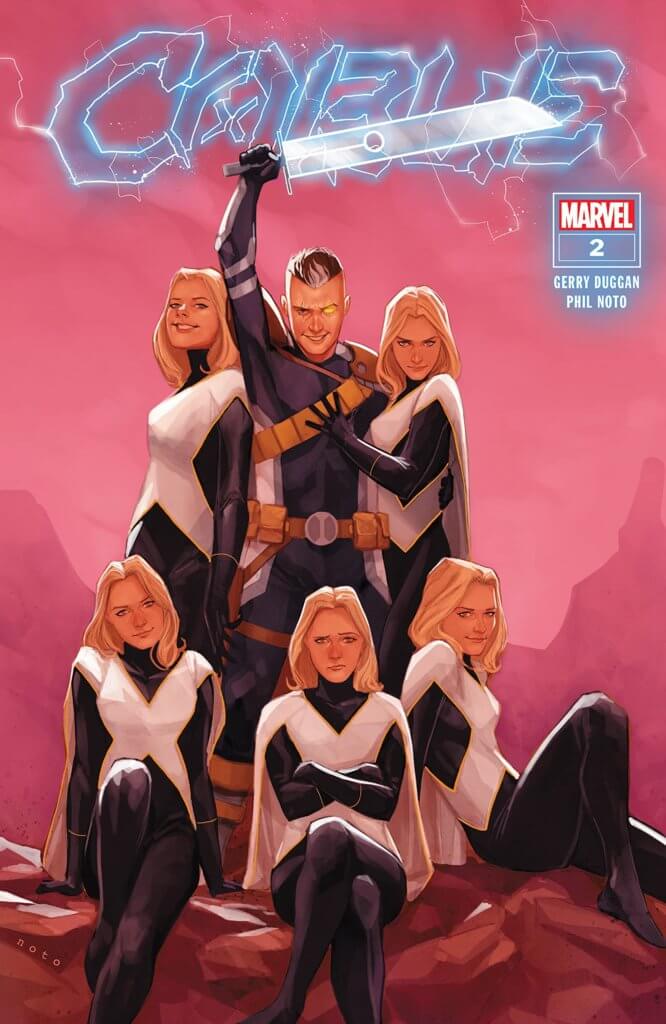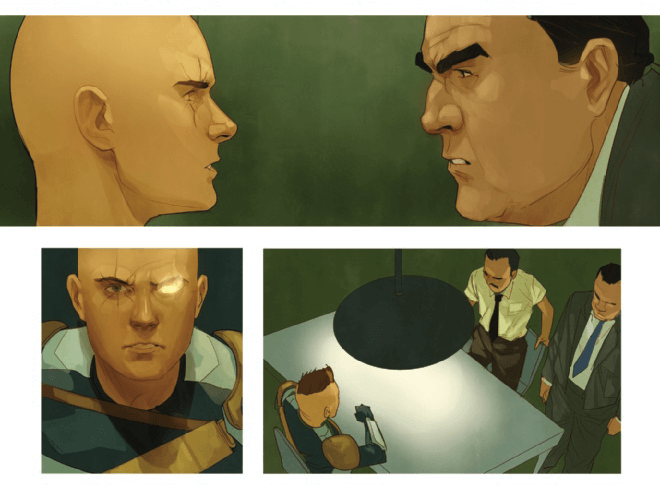I mentioned last time that Cable had been among my lowest expectations for the current line of X-Books, and how happy I was to be surprised. While the second issue feels a little slight in comparison, it’s got some really, really gratifying moments.
Cable #2
Gerry Duggan (Writer), Tom Muller (Design), Phil Noto (Art), Joe Sabino (Letterer)
Marvel Comics
July 29th, 2020

Granted, it’s hard to top that first issue. The Quarry was an inspired reveal, and the details about it that were teased through data pages only enhanced that. It also really made me enjoy Kid Cable for the first time, despite him being a character I really never wanted and worse, actively disliked during his reveal. Cable #2, titled “The Five In One,” is so named for his costars this time around, the Stepford Cuckoos, returned to their full number as of House of X. That young Nathan is dating them is a less grandiose reveal than the Quarry, perhaps, but the additional bit regarding the five of them toying with him is a deeply entertaining hook, one that I can’t wait to see more built on.
That said, the main crux of this book is the investigation of missing mutants. The opening scene in the book concerns Omerta, an ill-fated mutant from the final arc before Grant Morrison’s New X-Men revival, and his spouse Stinger, originally one of Apocalypse’s first subordinates (to us, the readers, not in canon, obviously). The point of the scene is that their baby goes missing from its crib, but it’s the dynamics on display beforehand that are fascinating to me. Stinger and Omerta are arguing about very relevant, real things, which is to say money, work, and the logistics of living a shared life. The couple still lives in the U.S., but Stinger wants to relocate to Krakoa, both for the opportunities and the safety for her baby (revealed in the Sinister Secrets page of Marauders #8). Omerta is worried about questions of citizenship and his lack of powers (presumably he is not informed enough to know about the Crucible, a detail I rather enjoy; information disseminates asymmetrically!), and whether they can move back to the U.S. in case it doesn’t work out.
These are stances that are True in a very real sense of the word; immigration is a difficult process even when you’re not actively fighting a regime that hates immigrants for existing. Similarly, making choices like this automatically become so much more complex when there is a baby involved; these arguments are never neat or easy. They’re messy and sometimes they don’t have great resolutions! It’s engaging to see, it gives these side characters weight, makes them feel like they matter in the scheme of things, and that’s phenomenal work on Duggan’s part.
It’s also interesting to me, to see Omerta in particular having a domestic argument. He’s essentially a stereotype of a character; his given name is Paulie Provenzano, likely named after the actual real-life mob boss Bernardo Provenzano, and he actually did try to join the mob before being turned away for being a mutant. Though he never actually took the name Omerta in his original appearances, it was nonetheless the name applied to him, and apparently one he uses now. To see an extremely Sicilian-coded character with heavy mafia themes engaging in a domestic argument of all things, well…it’s very Goodfellas, isn’t it? At any rate this is a very long aside for a relatively minor character thus far (although we still have yet to learn how he came back to life, pre-Krakoa, with no powers, despite dying two years before House of M).

Where was I? Oh yes, the main plot. It’s a police procedural, which probably felt like a much better idea before most of this year happened than it does now. That said, it gets by pretty well by focusing on Nathan and Esme as the investigators and framing the human police as generally both unhelpful and dismissive. I like it for that; not just because the framing feels relevant, but because it’s a good example that one can tell an actual investigative procedural story without centering police as the protagonists. Given how much of popular media relies on this kind of story, that example feels like it’s important to have. The scene itself feels like it could have used a little more attention artistically; there is a panel where Cable and one of these cops are having a close conversation, but it feels as though they’re…on different planes, relative to the viewer, like the cop is closer and Cable further away and they’re only pretending to look directly at one another, like that forced perspective trick Peter Jackson used in Lord of the Rings.
From there, the two get swept up in a fight with some Space Knights who come after the sword Nathan found in the first issue, lose, and get kidnapped. This sets the issue up for a bit of a redux, as Cyclops appears to question the police Nathan had spoken to earlier, this time about his own son’s disappearance. I suspect this gag is probably why the issue felt slight to me; upon writing it seems that isn’t really the case at all, because there are still two more meaty scenes after this; a hilarious sequence involving Cyclops and a sandwich, and also another nebulous future scene involving an adult Cable in some kind of wasteland. The last is as vague as the first issue’s related scene was; neither give us much information there as to what’s going on.
I have talked a lot about the story beats here and not much about Phil Noto’s art in particular, and that’s one of those things that can be difficult to do when an artist is turning in work that is consistently good but fundamentally unchanged from issue to issue. Everything I had to say last time about his choices, the way he manages to depict youth in a convincing manner, all of these things hold true. There are no special effects stunts involving Nathan’s glowing eye, but Noto still has his fun, doing what look like free-handed effects for the central fight scene of the issue. It’s an effective technique; white lined letters that aren’t filled in, laid directly over whatever effect they’re assisting; it presents the sound and the effect as one, and in a way where neither detracts from the other. His work on the older Cable sequences is also interesting; he shifts styles, and everything feels a little less finished in those; like he’s left original sketch lines in place rather than removing them. It’s a choice that won’t work for everyone, I think, but it’s one I quite like; it differentiates the two settings of the book, and it reminds me of nothing so much as Francis Manapul’s Flash work back when he first took over the book for the New 52.

Cable was probably one of the books most affected by the pandemic; like Wolverine, it had only just started, hadn’t had a chance to build any momentum or fanbase really, and now comes back during a time of unprecedented financial crisis in the U.S., when buying comics (especially at four dollars a pop) is one of the last things on a lot of people’s minds. That said, the work that Duggan and Noto are doing here is top notch, and I really hope the book is able to stick it out. Hey, if Cable stares dreamily at the Cuckoos with his glowing eye, is that the Light of Gal Adore?

